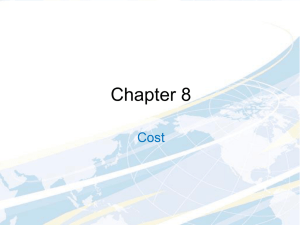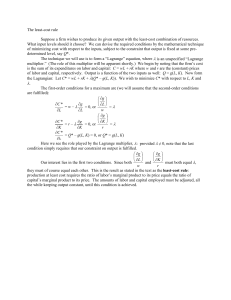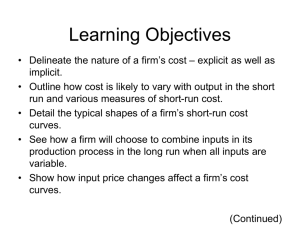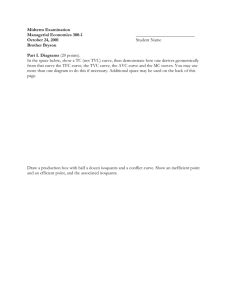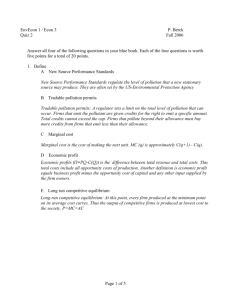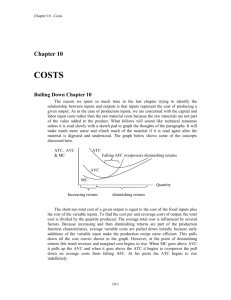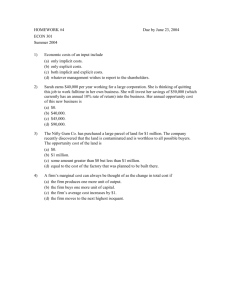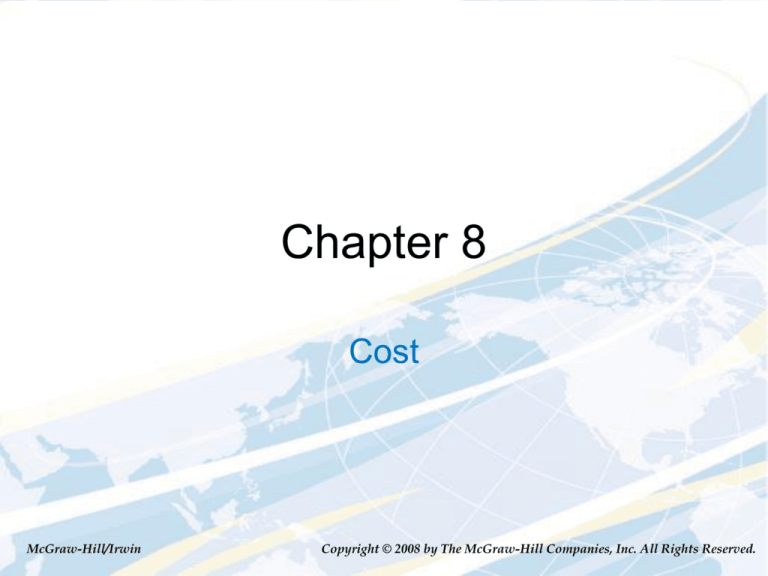
Chapter 8
Cost
McGraw-Hill/Irwin
Copyright © 2008 by The McGraw-Hill Companies, Inc. All Rights Reserved.
Main Topics
Types of cost
What do economic costs include?
Short-run cost: one variable input
Long-run cost: cost minimization with two
variable inputs
Average and marginal costs
Effects of input price changes
Economies and diseconomies of scale
8-2
Types of Cost
Firm’s total cost is the expenditure required to
produce a given level of output in the most
economical way
Variable costs are the costs of inputs that vary
with output level
Fixed costs do not vary as the level of output
changes, although might not be incurred if
production level is zero
Avoidable versus sunk costs
8-3
Production Costs: An Example
Table 8.1: Fixed, Variable, and Total Costs of Producing
Garden Benches
Number of
Benches
Produced per
Week
Fixed Costs
(per Week)
Variable Cost
(per Week)
Total Cost
(per Week)
0
$1,000
$0
$1,000
33
$1,000
500
1,500
74
$1,000
1,000
2,000
132
$1,000
2,000
3,000
8-4
Economic Costs
Some economic costs are hidden, such
as lost opportunities to use inputs in
other ways
Example: Using time to run your own firm
means giving up the chance to earn a salary
in another job
An opportunity cost is the cost
associated with forgoing the opportunity
to employ a resource in its best
alternative use
8-5
Short Run Cost:
One Variable Input
If a firm uses two inputs in production, one is
fixed in the short run
To determine the short-run cost function with
only one variable input:
Identify the efficient method for producing a given
level of output
This shows how much of the variable input to use
Firm’s variable cost = cost of that amount of input
Firm’s total cost = variable cost + any fixed costs
Can be represented graphically or
mathematically
8-6
Figure 8.1: Variable Cost from
Production Function
8-7
Figure 8.2: Fixed, Variable, and
Total Cost Curves
Dark red curve is
variable cost
Green curve is fixed
cost
Light red curve is
total cost, vertical
sum of VC and FC
8-8
Long-Run Cost: Cost Minimization
with Two Variable Inputs
In the long run, all inputs are variable
Firm will have many efficient ways to
produce a given amount of output, using
different input combinations
Which efficient combination is cheapest?
Consider a firm with two variable inputs K
and L, and inputs and outputs that are
finely divisible
8-9
Isocost Lines
An isocost line connects all input combinations with the
same cost
If W is the cost of a unit of labor and R is the cost of a
unit of capital, the isocost line for total cost C is:
WL RK C
Rearranged,
C W
K
R R
L
Thus the slope of an isocost line is –(W/R), the
negative of the ratio of input prices
8-10
Isocost Lines, continued
Isocost lines closer to the origin represent
lower total cost
A family of isocost lines contains, for given
input prices, the isocost lines for all possible
cost levels of the firm
Note the close relationship between isocost
lines and consumer budget lines
Lines show bundles that have same cost
Slope is negative of the price ratio
8-11
Sample Problem 1:
Plot the isocost line for a total cost of
$20,000 when the wage rate is $10 and the
rental rate is $40.
How does the isocost line change if the
wage rises to $20?
Least-Cost Production
How do we find the least-cost input
combination for a given level of output?
Find the lowest isocost line that touches the
isoquant for producing that level of output
No-Overlap Rule: The area below the isocost
line that runs through the firm’s least-cost input
combination does not overlap with the area
above the Q-unit isoquant
Again, note the similarities to the consumer’s
problem
8-13
Garden Bench Example,
Continued
In the long run, Naomi and Noah can
vary the amount of garage space they
rent and the number of workers they hire
An assembly worker earns $500 per
week
Garage space rents for $1 per square
foot per week
Inputs are finely divisible
8-14
Figure 8.7: Least-Cost Method,
No-Overlap Rule Example
Square Feet
of Space, K
A
2500
2000
D
1500
B
1000
Q = 140
C = $3500
500
C = $3000
1
2
3
4
5
6
Number of Assembly
Workers, L
8-15
Interior Solutions
A least-cost input combination that uses at
least a little bit of every input is an interior
solution
Interior solutions always satisfy the tangency
condition: the isocost line is tangent to the
isoquant there
Otherwise, the isocost line would cross the isoquant
Create an area of overlap between the area under
the isocost line and the area above the isoquant
This would not minimize the cost of production
8-16
Least-Cost Production and MRTS
Restate the tangency condition in terms of marginal
products and input prices:
Slope of isoquant = -(MRTSLK)
MRTS = ratio of marginal products
Slope of isocost lines = -(W/R)
Thus the tangency condition says:
MPL W
MPK
R
or
MPL MPK
W
R
Marginal product per dollar spent must be equal
across inputs when the firm is using a least-cost input
combination
8-17
Least-Cost Input Combination
How can we find a firm’s least-cost input combination?
If isoquant for desired level of output has declining
MRTS:
Find an interior solution for which the tangency condition
formula holds
That input combination satisfies the no-overlap rule and must
be the least-cost combination
If isoquant does not have declining MRTS:
First identify interior combinations that satisfy the tangency
condition, if any
Compare the costs of these combinations to the costs of any
boundary solutions
8-18
Sample Problem 2:
Suppose the production function for
Gadget World is Q = 5L0.5K0.5. The wage
rate is $25 and the rental rate is $50.
What is the least-cost combination of
producing 100 gadgets? 200?
The Firm’s Cost Function
To determine the firm’s cost function need to
find least-cost input combination for every
output level
Firm’s output expansion path shows the
least-cost input combinations at all levels of
output for fixed input prices
Firm’s total cost curve shows how total cost
changes with output level, given fixed input
prices
8-20
Figure 8.10: Output Expansion
Path and Total Cost Curve
8-21
Average and Marginal Cost
A firm’s average cost, AC=C/Q, is its cost per unit of
output produced
Marginal cost measures now much extra cost the
firm incurs to produce the marginal units of output, per
unit of output added
C C Q C Q Q
MC
Q
Q
As output increases:
Marginal cost first falls and then rises
Average cost follows the same pattern
8-22
Cost, Average Cost, and
Marginal Cost
Table 8.3: Cost, Average Cost, and Marginal Cost for a
Hypothetical Firm
Output (Q)
Tons per day
Total Cost (C)
(per day)
Marginal Cost
(per day)
Average Cost
(per day)
0
$0
$0
$0
1
1,000
1,000
1,000
2
1,800
800
900
3
2,100
300
700
4
2,500
400
625
5
3,000
500
600
6
3,600
600
600
7
4,300
700
614
8
5,600
1,300
700
8-23
AC and MC Curves
When output is finely divisible, can represent
AC and MC as curves
Average cost:
Pick any point on the total cost curve and draw a
straight line connecting it to the origin
Slope of that line equals average cost
Efficient scale of production is the output level at
which AC is lowest
Marginal cost:
Firm’s marginal cost of producing Q units of output
is equal to the slope of its cost function at output
level Q
8-24
Figure 8.16: Relationship
Between AC and MC
AC slopes downward
where it lies above
the MC curve
AC slopes upward
where it lies below
the MC curve
Where AC and MC
cross, AC is neither
rising nor falling
8-25
Marginal Cost, Marginal Products,
and Input Prices
Intuitively, a firm’s costs should be lower the
more productive it is and the lower the input
prices it faces
Formalize relationship between marginal cost,
marginal products, and input prices using the
tangency condition:
R
W
MC
MPK MPL
8-26
More Average Costs: Definitions
Apply idea of average cost to firm’s variable
and fixed costs to find average variable cost
and average fixed cost:
VC
AVC
Q
FC
AFC
Q
Since total cost is the sum of variable and
fixed costs, average cost is the sum of AVC
and AFC:
C VC FC VC FC
AC
AVC AFC
Q
Q
Q
Q
8-27
Average Cost Curves
Fixed costs are constant so AFC is
always downward sloping
At each level of output the AC curve is
the vertical sum of the AVC and AFC
curves
Average cost curve lies above both AVC and
AFC at every output level
Efficient scale of production exceeds output
level where AVC is lowest
8-28
Figure 8.18: AC, AVC, and
AFC Curves
8-29
Figure 8.20: AC, AVC, and
MC Curves
8-30
Effects of Input Price Changes
Changes in input prices usually lead to
changes in a firm’s least-cost production
method
Responses to a Change in an Input Price:
When the price of an input decreases, a firm’s leastcost production method never uses less of that input
and usually employs more
For a price increase, a firm’s least-cost input
production method never uses more of that input
and usually employs less
8-31
Figure 8.21: Effect of an Input
Price Change
Point A is optimal
input mix when price
of labor is four times
more than the price
of capital
Point B is optimal
when labor and
capital are equally
costly
8-32
Short-run vs. Long-run Costs
In the long run a firm can vary all inputs
Will choose least-cost input combination for each output level
In the short run a firm has at least one fixed input
Produce some level of output at least-cost input combination
Can vary output from that in short run but will have higher
costs than could achieve if all inputs were variable
Long-run average variable cost curve is the lower
envelope of the short-run average cost curves
One short-run curve for each possible level of output
8-33
Figure 8.24: Input Response over
the Long and Short Run
8-34
Figure 8.25: Long-run and Shortrun Costs
8-35
Figure 8.26: Long-run and Shortrun Average Cost Curves
8-36
Economies and Diseconomies of
Scale
What are the implications of returns to scale?
A firm experiences economies of scale when
its average cost falls as it produces more
Cost rises less, proportionately, than the increase in
output
Production technology has increasing returns to
scale
Diseconomies of scale occur when average
cost rises with production
8-37
Figure 8.28: Returns to Scale and
Economies of Scale
8-38
Sample Problem 3 (8.12):
Noah and Naomi want to produce 100 garden
benches per week in two production plants. The
cost functions at the two plants are
C1 600Q1 3Q
2
1
C2 650Q2 2Q
2
2
and
,
and the corresponding marginal costs are MC1 =
600 – 6Q1 and MC2 = 650 – 4Q2. What is the best
output assignment between the two plants?

